This was published 2 years ago
International travel after COVID-19: The future of airlines, airports and travel overseas
By Lee Tulloch
When supermodel Naomi Campbell posted a YouTube video of her in-plane germ prevention routine last year, it looked, at the time, a little on the obsessive side.
Now, that's all of us. A vanguard of international travellers working their way through the labyrinth of health and border control regulations report horror stories about longer lines and onerous new requirements.
But, believe it or not, experts predict the golden age of air travel, and for that matter airports, is still to come. That's good news, since despite the best intentions of a handful of billionaires determined to hustle in the era of space tourism, most of the world's travellers will be sticking within the Earth's atmosphere when they fly, at least for the foreseeable future.
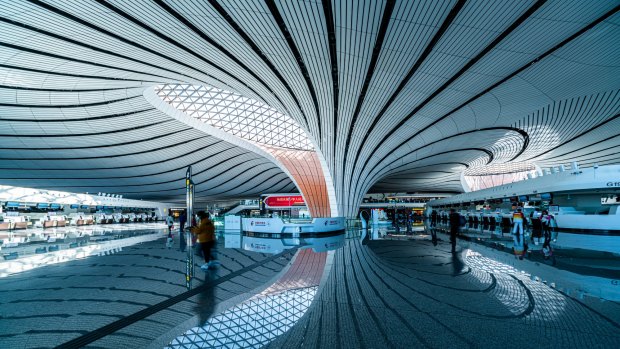
Daxing New International Airport, Beijing, China, is the world's largest airport, servicing 100 million passengers annually. Credit: iStock
Yet that doesn't mean the experience of air travel in 2022 and beyond will be the same as it was in 2019. For a start, the pandemic has already heralded new protocols such as compulsory facemasks, PCR tests, vaccination passports and yes, deep cleaning (see below on negotiating airports in the age of COVID).
Fear not, or not too much. Looking ahead, there is hope, as navigating airports and flight departures will progressively become a markedly smoother experience, from doorstep to arrival at the destination, drawing on new developments in technology, from biometrics to robotics and AI.
FAREWELL TO EMOTIONAL BAGGAGE
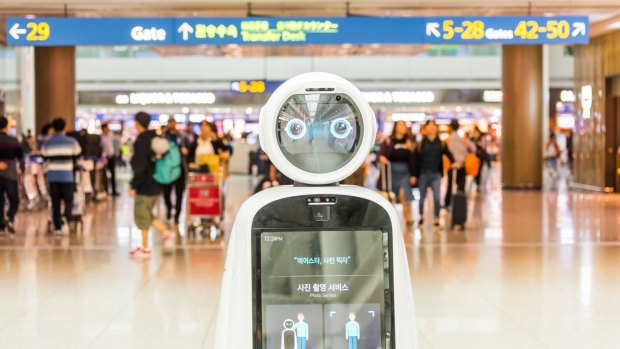
.
Eshaghian is part of the team spearheading a $US14.5 billion capital improvements program at LAX, the gateway to the US for most Australians. But will this really mean the end of the miserable airport experience, including at the traditionally largely unloved LAX? Will those long lines be a thing of the past?
In years to come, hopefully post-COVID, the airport experience will be mostly contactless, utilising biometrics, including facial and iris recognition, to identify passengers as soon as they enter the terminal, allowing them to manoeuvre pinch points such as security and immigration without fumbling for documents or waiting in long lines.
Passengers will glide through the building on people movers or electrified vehicles, their journeys recorded on invisible sensors that will open gates and clear security automatically.
"We're going to start seeing a far more sophisticated, futuristic type of journey and process experience,' says Ken Conway, head of Sustainable Aviation at Airbiz, a boutique, Australian-based aviation consultancy firm.
"You'll almost get yourself airside and not have realised that has happened. Your journey starts from the point where you leave your front door, not the point where you enter the terminal building."
One major tool is the development of new generation in-phone apps that will calculate the time when you need to leave home for the airport and automatically order an Uber or taxi to get you there, reducing one of the major causes of travel stress – will I miss my flight?
Once in the terminal, animated chat bots or robots will greet you and answer your questions along the route. And, according to Eshaghian, this will mean no more lost baggage. He says; "Your baggage is going to be tagged by an identifier that will update you every five minutes, if you want, where your bag is going to be along the journey once you've checked it."
Even better, we won't have to wait until 2050 – some of this is already happening in the world's most advanced airports.
LOVE AND HATE ACTUALLY
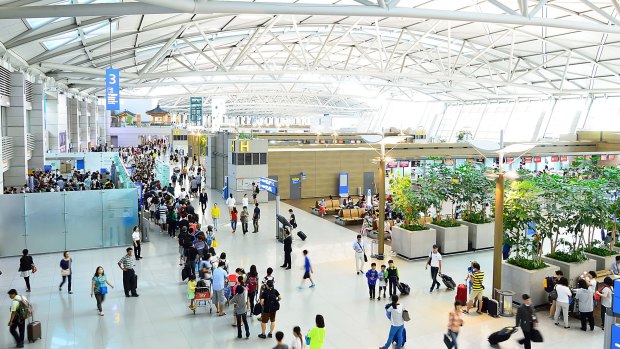
. Credit: iStock
Most travellers have a love-hate relationship with airports. The "love" part is the thrill of going somewhere that entering a terminal generates. Carolyn Childs, Futurist at MyTravelResearch.com, calls it the "shared vision'" of being at an airport. "You don't like standing in a queue but the excitement around you when you see other passengers having that experience, for me it's one of the pleasures of travel."
Then there are those Love Actually moments, as she calls them, in the arrivals halls, when families and loved ones unite after long separations. Since COVID, it's now a much more intense emotional experience, as we saw when New Zealand reopened its borders to Australia in April.
The "hate" part is the necessary and sometimes unnecessary barriers passengers have to endure before they can finally relax into their seats on the plane. The number one pet hate for most travellers is a universal one: "Security", says well-travelled international hotel designer Bill Bensley, echoing the sentiments of millions of other flyers.
Passengers are still dealing with often inconsistent security measures brought in 20 years ago, after the September 11, 2001, attacks in New York. Now vaccination passports and COVID testing documentation have the potential to add further snarls to a system that's tedious at the best of times.
But, as mentioned, the future is already happening in small but significant ways. In Terminal 5 at Heathrow authorities are trialling biometric boarding, eliminating the need for boarding passes, and autonomous robots which answer passengers' questions about flights in several languages.
At Changi, Singaporeans arriving in Terminal 4 can walk through immigration without showing their passports, thanks to biometric sensors. Miami and Amsterdam Schiphol airports send push notifications to passengers alerting them to flight information.
For many years now passengers departing from Hong Kong have been able to drop off their bags up to a day ahead of their flight at a kiosk at the MTR subway in Hong Kong or Kowloon and not see it again until they arrive at their final destination.
Forward thinking airports have instigated processes to make new health protocols simpler for passengers. At Heathrow, Virgin Atlantic and British Airways have opened express lanes for vaccinated travellers. At Los Angeles, there's only a 30-minute turn around for a PCR COVID test.
Eshaghian is keen to get Australians flying back through LAX and has proposed test flights for vaccinated people, who will be given PCR tests both 72 hours ahead of the flight and just before boarding.
"Over a couple of months we'd have enough data to show it's impossible to transmit the virus that way," he says. Unfortunately, he says, the Australian government is unimpressed. 'It's like moving the earth to convince them."
Hopefully, the pandemic will settle and the new protocols will be integrated smoothly. The next frontier for aviation and airports is the flightpath to net zero.
READY FOR TAKEOFF: THE GREEN AIRPORT
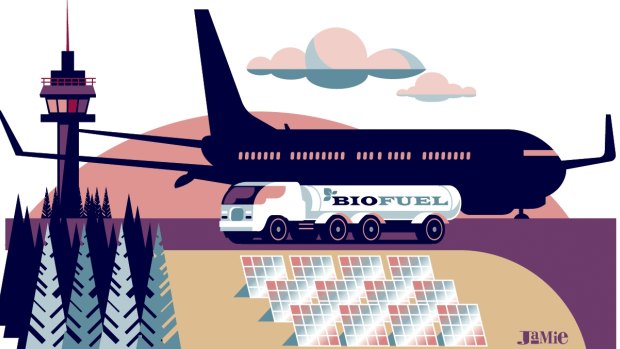
The face of airports and airlines is changing. Credit: Illustration: Jamie Brown
While those numbers might look rosy for the operators of airports and airlines, right now they are in survival mode, with activity levels falling off a cliff and balance sheets slashed in every region of the world. But it has also been a time of innovation, driven by the business imperative that airports and aviation must be more sustainable.
Aviation accounts for two to three per cent of global greenhouse gas emissions. By 2050 aircraft-generated emissions are expected to triple, according to the International Civil Aviation Authority. The global aviation industry has committed to the Paris Agreement Climate goals of 1.5 degree warming limit, and net zero carbon by 2050.
But the industry is still heavily reliant on fossil fuels and lacks consistent policies, as no two airports are the same and regulations vary wildly from country to country.
In 30 years' time things might be different. It's possible we'll be travelling in aircraft powered by 100 per cent renewable energy or in purely electric-operated planes. We're starting to see some of the technology now. United Airlines has ordered 15 Supersonic Overture aircraft which boast net carbon zero emissions, which the airline expects to be flying commercially by 2029.
Now, however, about half a million kilos of batteries would be needed to power one 747 jet engine, so the electric age won't be with us until batteries are much lighter. Hybrid-electricity planes and biofuels are the way forward for the moment.
"There now is an absolute appreciation that the status quo is simply not acceptable anymore," says Airbiz's Conway.
"Action needs to begin now. We need to change the way we plan and develop our airports."
Conway points out that airports don't own, operate, design or manufacture aircraft, so decarbonisation has to be focused on the terminal building, ground based vehicles and equipment fleets.
In the future, as you taxi down the runway, you may be looking out the window at more than the flat aprons of grass that these days line the tarmac. You might accelerate past a solar farm, a solar energy storage plant and a biomass plantation that provides feedstock to the bioenergy plant. Beside the runway will be natural carbon sinks to absorb and sequestrate CO 2.
There will be greener on-ground operations, such as solar supply at the gate and autonomous electric pushback tractors. The terminal will be a low-carbon building utilising eco-certified products and sustainable produce. Single-use plastics will be nowhere in sight.
Many world airports, such as Sydney, are land constrained, so developers are looking at partnerships outside the fence, acquiring land to house smart renewable energy systems like natural carbon banks or buying wind power from several hundred kilometres away.
Northern European airports are pushing the boundaries, Conway says. Swedish airports are the industry standout, already generating zero CO 2 emissions from operations with a target of fossil free domestic air travel by 2030.
Planned to open in 2026 on a parcel of bushland at Badgerys Creek, 44 kilometres west of Sydney's CBD, Nancy-Bird Walton Airport represents an opportunity to build from the ground up a major city airport with sustainability and technological innovation at its core.
The design, by COX Architects in Australia and London-based Zaha Hadid architects, will focus on a sense of place, the bushland, so the experience inside will be like walking through a forest of trees. Woods Bagot will lead the final design development of the airport.
With the need for medical approvals such as vaccine passports in order for people to travel, the new airport will include a dedicated health and testing facility. Touchless amenities, facial scanning and iris recognition are part of the concept.
Departing and arriving passengers will move through an airy pavilion called The Great Australian Light, an orienting space, which will allow people to subliminally know where to go as they move between levels, reducing that familiar airport anxiety. We can't wait.
JET SET TO GET SET: YOUR FIRST INTERNATIONAL FLIGHT IN THE COVID ERA

. Credit: Ilustration: Jamie Brown
BEFORE YOUR LEAVE HOME
Electronic vaccine certificates, either via an app or a QR-code on your smartphone, will be essential. In many cases, you'll also need proof of a negative PCR test within 48 hours of departure, though it may be as easy as getting a rapid PCR test done at the airport for a fee. Before you leave you may want to apply for and download health passes such as the French Pass Sanitaire or the Italian Green Pass for access to indoor venues like restaurants.
CHECKING IN
Hand-held infrared thermometers or thermal cameras will scan you as you enter the airport and those with a temperature will be denied access. Masks will be mandatory throughout the terminal. Check-in staff will be protected by Plexiglass and face shields and the process will be contactless, with biometric check-in at a kiosk, using your face as identification, becoming more common. Check in for international flights is still recommended three hours ahead.
PRE-FLIGHT
Expect physical-distancing and marked lanes for moving through the airport but that will probably be a plus as scrums of passengers huddling around boarding gates will be redundant. Security clearance will increasingly be biometric, as will entry to lounges. Terminals will be noticeably cleaner, with robots employed at airports such as Hong Kong.
BOARDING AND ON BOARD
Airlines like Emirates are boarding passengers in smaller groups. All cabin crew wear masks and you will likely still need to do so as well. Don't expect a vacant seat next to you – airlines will be keen to fill their planes though vaccine mandates and pre-flight PCR tests will mean the person next to you is COVID-free.
ARRIVAL
Depending on the destination, there will be health requirements on arrival, ranging from temperature checks to rigorous processes at the likes of Singapore's Changi Airport where vaccinated passengers need to prepay for a PCR test on arrival and then isolate until a negative PCR test is received, followed by PCR tests on day three and seven.
FIVE ANNOYING THINGS AT AIRPORTS WE'D LIKE FIXED
LINES, LINES, LINES
We accept that queues are necessary at certain points along the route in the terminal, but poorly managed lines, such as funnelling several plane loads of passengers into two or three immigration counters are not.
WHAT? ANOTHER LINE?
You've passed through security and immigration and are all excited to reach your gate. And then you find out you have to line up for a bus, which will take you ages to your real gate as it meanders around the airport.
NONSENSICAL SECURITY RULES
Do we really still need to take off our shoes? Why do some airports still insist on banning liquids over 100 millilitres, yet others don't? We need to know the reasons behind the rules, lest they test our patience to the limit.
FREE US FROM DUTY FREE
Do we really have to drag our way through convoluted aisles of duty free shops to get to our gate? Poorly designed airports that put the emphasis on the commercial just feel manipulative.
It's hard enough staggering off a long-haul flight without having to go on a scavenger hunt for connections and other info. A special personalised in-phone airport app that is activated as soon as you arrive would be a game-changer.
FIVE AIRPORTS OF THE FUTURE THAT HAVE ALREADY LANDED
AMSTERDAM SCHIPHOL, THE NETHERLANDS
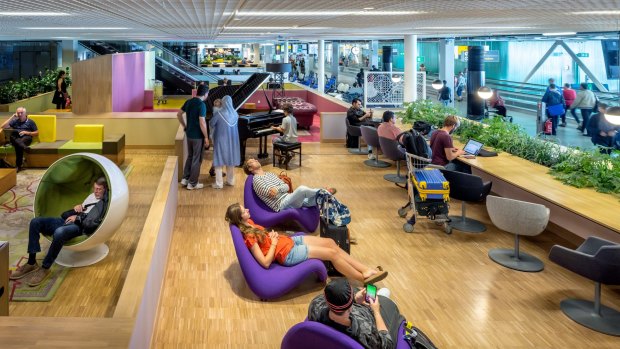
The Holland Boulevard at Amsterdam Schipol. Credit: Thijs Wolzak
The Skytrax Best Airport in Western Europe for 2020 is one of the best airports for a long layover. There's a full library offering books in many languages, an annex of the Dutch National Museum that features 17th Century Dutch masterpieces, and a forest-like area where you can charge your phone on a stationary bike. See schiphol.nl
OSLO GARDERMOEN, NORWAY
Touted as the world's most environmentally efficient airport, Oslo's main airport features a soaring new pier made of recycled timbers and glass with exceptional energy conservation qualities. It's cooled by the past season's snow in summer and warmed by treated sewage in winter. See avinor.no
CHRISTCHURCH, NEW ZEALAND
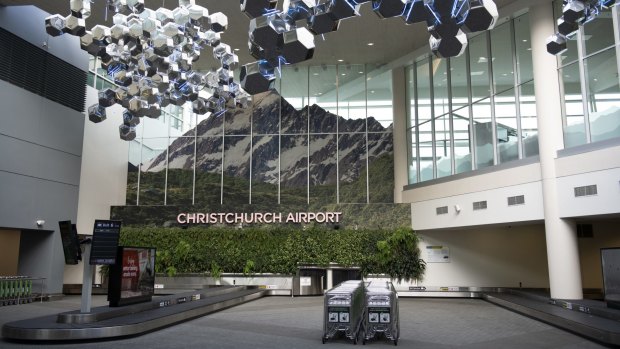
Christchurch Airport in New Zealand and a world leader in carbon reduction.
BEIJING DAXING, CHINA

Daxing New International Airport, Beijing, China. Credit: iStock
The world's largest airport, servicing 100 million passengers annually, resembles a six-armed sprawling starfish. Its clever design means the transit distance from security to the furthest gate is only about 600 metres with advanced facial recognition for identity verification and a paperless luggage-tracking system. See daxing-pkx-airport.com
Sign up for the Traveller newsletter
The latest travel news, tips and inspiration delivered to your inbox. Sign up now.